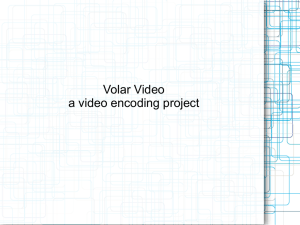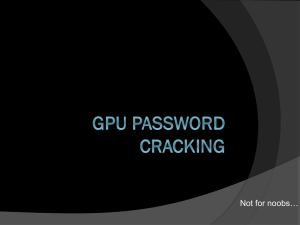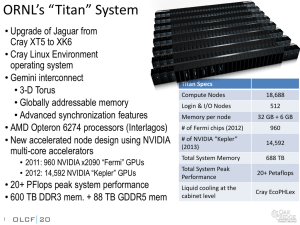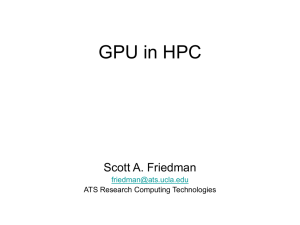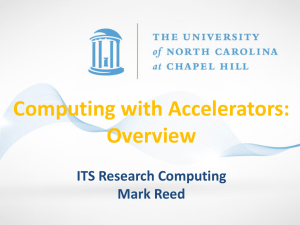CUDA Libraries
advertisement
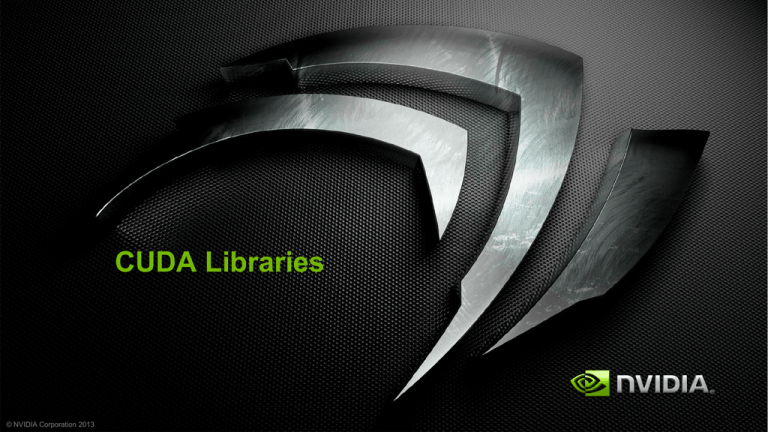
CUDA Libraries
© NVIDIA Corporation 2013
Why Use Library
No need to reprogram
Save time
Less bug
Better Performance
© NVIDIA Corporation 2013
= FUN
CUDA Math Libraries
High performance math routines for your applications:
cuFFT – Fast Fourier Transforms Library
cuBLAS – Complete BLAS Library
cuSPARSE – Sparse Matrix Library
cuRAND – Random Number Generation (RNG) Library
NPP – Performance Primitives for Image & Video Processing
Thrust – Templated C++ Parallel Algorithms & Data Structures
math.h - C99 floating-point Library
Included in the CUDA Toolkit
© NVIDIA Corporation 2013
Free download @ www.nvidia.com/getcuda
Linear Algebra
© NVIDIA Corporation 2013
A Birds Eye View on Linear Algebra
Vector
Matrix
Matrix
Solver
© NVIDIA Corporation 2013
A Birds Eye View on Linear Algebra
Dense
Multi
Node
Sparse
Vector
Single
Node
Matrix
Matrix
Solver
© NVIDIA Corporation 2013
Sometimes it seems as if there’s only three …
Dense
ScaLAPACK
Multi
Node
Sparse
BLAS
Matrix
Matrix
LAPACK
Solver
© NVIDIA Corporation 2013
Single
Node
Vector
.. but there is more …
ScaLAPACK
PaStix
Paradiso
TAUCS SuperLU
WSMP MUMPS
UMFPACK
Spooles
PLAPACK
Multi
Node
Dense
Sparse
PBLAS
SparseBLAS
LINPACK
BLAS
Matrix
Matrix
LAPACK
Solver
© NVIDIA Corporation 2013
Single
Node
Vector
EISPACK
… and even more ..
Trilinos
ScaLAPACK
PaStix
Matlab
Paradiso
TAUCS SuperLU
WSMP MUMPS
UMFPACK
Spooles
PLAPACK
Multi
Node
Dense
Sparse
PETSc
PBLAS
SparseBLAS
LINPACK
BLAS
R, IDL,Matrix
Python,
Matrix Ruby, ..
LAPACK
Solver
© NVIDIA Corporation 2013
Single
Node
Vector
EISPACK
NVIDIA CUDA Library Approach
Provide basic building blocks
Make them easy to use
Make them fast
Provides a quick path to GPU acceleration
Enables ISVs to focus on their “secret sauce”
Ideal for applications that use CPU libraries
© NVIDIA Corporation 2013
NVIDIA’s Foundation for LinAlg on GPUs
Dense
Parallel
Sparse
NVIDIA cuSPARSE
Vector
NVIDIA cuBLAS
Single
Node
Matrix
Matrix
Solver
© NVIDIA Corporation 2013
cuBLAS: >1 TFLOPS double-precision
Up to 1 TFLOPS sustained performance and
>8x speedup over Intel MKL
• cuBLAS 5.0, K20
• MKL 10.3.6, Intel SandyBridge E5-2687W @ 3.10GHZ
Performance may vary based on OS version and motherboard configuration
© NVIDIA Corporation 2013
cuBLAS: Legacy and Version 2 Interface
Legacy Interface
Convenient for quick port of legacy code
Version 2 Interface
Reduces data transfer for complex algorithms
Return values on CPU or GPU
Scalar arguments passed by reference
Support for streams and multithreaded environment
Batching of key routines
© NVIDIA Corporation 2013
Version 2 Interface helps reducing memory
transfers
Index transferred to
Legacy Interface
CPU, CPU needs
vector elements for
scale factor
idx = cublasIsamax(n, d_column, 1);
err = cublasSscal(n, 1./d_column[idx], row, 1);
© NVIDIA Corporation 2013
Version 2 Interface helps reducing memory
transfers
Index transferred to
Legacy Interface
CPU, CPU needs
vector elements for
scale factor
idx = cublasIsamax(n, d_column, 1);
err = cublasSscal(n, 1./d_column[idx], row, 1);
Version 2 Interface
err = cublasIsamax(handle, n, d_column, 1, d_maxIdx);
kernel<<< >>> (d_column, d_maxIdx, d_val);
err = cublasSscal(handle, n, d_val, d_row, 1);
All data remains
on the GPU
© NVIDIA Corporation 2013
The cuSPARSE - CUSP Relationship
Dense
Parallel
Sparse
NVIDIA cuSPARSE
Matrix
Solver
© NVIDIA Corporation 2013
Single
Node
Vector
Third Parties Extend the Building Blocks
Dense
Multi
Node
Sparse
Vector
FLAME
Single
Node
Library
Matrix
Solver
IMSL Library
© NVIDIA Corporation 2013
Third Parties Extend the Building Blocks
Dense
Multi
Node
Sparse
Vector
FLAME
Single
Node
Library
Matrix
Solver
IMSL Library
© NVIDIA Corporation 2013
Different Approaches to Linear Algebra
CULA tools (dense, sparse)
LAPACK based API
Solvers, Factorizations, Least Squares, SVD, Eigensolvers
Sparse: Krylov solvers, Preconditioners, support for
various formats
culaSgetrf(M, N, A, LDA, IPIV, INFO)
ArrayFire
“Matlab-esque” interface \C \Fortran
Array container object
Solvers, Factorizations, SVD, Eigensolvers
array out = lu(A)
© NVIDIA Corporation 2013
ArrayFire Matrix
Computations
Different Approaches to Linear Algebra
(cont.)
MAGMA
LAPACK conforming API
Magma BLAS and LAPACK
High performance by utilizing both GPU and CPU
magma_sgetrf(M, N, A, LDA, IPIV, INFO)
LibFlame
LAPACK compatibility interface
Infrastructure for rapid linear algebra algorithm
development
FLASH_LU_piv(A, p)
© NVIDIA Corporation 2013
FLAME Library
Toolkits are increasingly supporting GPUs
PETSc
GPU support via extension to Vec
and Mat classes
Partially dependent on CUSP
MPI parallel, GPU accelerated solvers
Trilinos
GPU support in KOKKOS package
Used through vector class Tpetra
MPI parallel, GPU accelerated solvers
© NVIDIA Corporation 2013
Signal Processing
© NVIDIA Corporation 2013
Common Tasks in Signal Processing
Filtering
© NVIDIA Corporation 2013
Correlation
Segmentation
Vector Signal
Image Processing
Parallel Computing
Toolbox
ArrayFire Matrix
Computations
GPU Accelerated
Data Analysis
NVIDIA NPP
Libraries for GPU Accelerated
Signal Processing
© NVIDIA Corporation 2013
Basic concepts of cuFFT
Interface modeled after FFTW
Simple migration from CPU to GPU
fftw_plan_dft2_2d => cufftPlan2d
“Plan” describes data layout, transformation strategy
Depends on dimensionality, layout, type of transform
Independent of actual data, direction of transform
Reusable for multiple transforms
Execution of plan
Depends on transform direction, data
cufftExecC2C(plan, d_data, d_data, CUFFT_FORWARD)
© NVIDIA Corporation 2013
Efficient use of cuFFT
Perform multiple transforms with the same plan
Use e.g. in forward/inverse transform for convolution,
transform at each simulation timestep, etc.
Transform in streams
cufft functions do not take a stream argument
Associate a plan with a stream via
cufftSetStream(plan, stream)
Batch transforms
Concurrent execution of multiple identical transforms
Support for 1D, 2D and 3D transforms
© NVIDIA Corporation 2013
High 1D transform performance is key to
efficient 2D and 3D transforms
Performance may vary based on OS version and motherboard configuration
© NVIDIA Corporation 2013
• Measured on sizes that are exactly powers-of-2
• cuFFT 5.0 on K20
Basic concepts of NPP
Collection of high-performance GPU processing
Initial focus on Image, Video and Signal processing
Growth into other domains expected
Support for multi-channel integer and float data
C API => name disambiguates between data types, flavor
nppiAdd_32f_C1R (…)
“Add” two single channel (“C1”) 32-bit float (“32f”) images, possibly
masked by a region of interest (“R”)
© NVIDIA Corporation 2013
NPP features a large set of functions
Arithmetic and Logical Operations
Add, mul, clamp, ..
Threshold and Compare
Geometric transformations
Rotate, Warp, Perspective transformations
Various interpolations
Compression
jpeg de/compression
Image processing
Filter, histogram, statistics
© NVIDIA Corporation 2013
NVIDIA NPP
cuRAND
© NVIDIA Corporation 2013
Random Number Generation on GPU
Generating high quality random numbers in parallel is hard
Don’t do it yourself, use a library!
Large suite of generators and distributions
XORWOW, MRG323ka, MTGP32, (scrambled) Sobol
uniform, normal, log-normal
Single and double precision
Two APIs for cuRAND
Host: Ideal when generating large batches of RNGs on GPU
Device: Ideal when RNGs need to be generated inside a kernel
© NVIDIA Corporation 2013
cuRAND: Host vs Device API
Host API
Generate set of
random numbers
at once
#include “curand.h”
curandCreateGenarator(&gen, CURAND_RNG_PSEUDO_DEFAULT);
curandGenerateUniform(gen, d_data, n);
Device API
#include “curand_kernel.h”
__global__ void generate_kernel(curandState *state) {
int id = threadIdx.x + blockIdx.x * 64;
x = curand(&state[id]);
Generate random
}
numbers per thread
© NVIDIA Corporation 2013
cuRAND Performance compared to Intel MKL
Performance may vary based on OS version and motherboard configuration
© NVIDIA Corporation 2013
• cuSPARSE 5.0 on K20X, input and output data on device
• MKL 10.3.6 on Intel SandyBridge E5-2687W @ 3.10GHz
Next steps..
© NVIDIA Corporation 2013
Thurst: STL-like CUDA Template Library
Device and host vector class
thrust::host_vector<float> H(10, 1.f);
thrust::device_vector<float> D = H;
Iterators
C++ STL Features
for CUDA
thrust::fill(D.begin(), D.begin()+5, 42.f);
float* raw_ptr = thrust::raw_pointer_cast(D);
Algorithms
Sort, reduce, transformation, scan, ..
thrust::transform(D1.begin(), D1.end(), D2.begin(), D2.end(),
thrust::plus<float>());
// D2 = D1 + D2
© NVIDIA Corporation 2013
OpenACC: New Open Standard for GPU
Computing
Faster, Easier, Portability
http://www.openacc-standard.org
© NVIDIA Corporation 2013
Vector Addition using OpenACC
void vec_add(float *x,float *y,int n)
{
#pragma acc kernels
for (int i=0;i<n;++i)
y[i]=x[i]+y[i];
}
float *x=(float*)malloc(n*sizeof(float));
float *y=(float*)malloc(n*sizeof(float));
vec_add(x,y,n);
free(x);
free(y);
void vec_add(float *x,float *y,int n)
{
for (int i=0;i<n;++i)
y[i]=x[i]+y[i];
}
float *x=(float*)malloc(n*sizeof(float));
float *y=(float*)malloc(n*sizeof(float));
vec_add(x,y,n);
free(x);
free(y);
#pragma acc kernels: run the loop in parallel on GPU
© NVIDIA Corporation 2013
OpenACC Basics
Compute construct for offloading calculation to GPU
#pragma acc parallel
#pragma acc parallel
for (i=0; i<n;i++)
a[i] = a[i] + b[i];
Data construct for controlling data movement between CPU-GPU
#pragma acc data copy (list) / copyin (list) / copyout (list) / present (list)
© NVIDIA Corporation 2013
#pragma acc data copy(a[0:n-1]) copyin(b[0:n-1])
{
#pragma acc parallel
for (i=0; i<n;i++)
a[i] = a[i] + b[i];
#pragma acc parallel
for (i=0; i<n;i++)
a[i] *= 2;
}
Math.h: C99 floating-point library + extras
© NVIDIA Corporation 2013
Explore the CUDA (Libraries) Ecosystem
CUDA Tools and
Ecosystem described in
detail on NVIDIA Developer
Zone:
developer.nvidia.com/cudatools-ecosystem
Attend GTC library talks
© NVIDIA Corporation 2013
Examples
© NVIDIA Corporation 2013
Questions
© NVIDIA Corporation 2013
